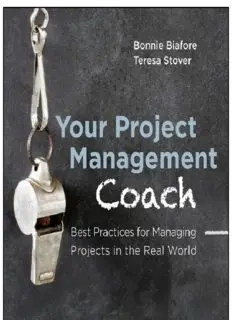
Your Project Management Coach: Best Practices for Managing Projects in the Real World PDF
Preview Your Project Management Coach: Best Practices for Managing Projects in the Real World
Table of Contents Part I: Understanding Projects and Project Management Chapter 1: Getting to Know Projects What Is a Project? How Do Projects Differ from Other Work? Summary Coach's Review Chapter 2: Getting to Know Project Management What Is Project Management? Project Management Processes: Start to Finish Balancing Scope, Time, Cost, and Quality Project Management Methodologies Project Management Knowledge Areas Who Makes a Good Project Manager? Summary Coach's Review Part II: Planning a Project Chapter 3: Getting a Project Off the Ground From Idea to Project: An Overview of Project Initiation Defining a Project Identifying the Project Stakeholders Preparing the Project Proposal Getting Approval or Sign-Off Publicizing the Project Charter Assembling the Project Notebook Summary Coach's Review Chapter 4: Getting to Know a Project Plan What Work Has to Be Done? How Much Will the Project Cost? Who Will Do the Work? When Will the Project Be Done? How Will the Project Be Managed? Summary Coach's Review Chapter 5: Identifying the Work to Be Completed Understanding the Work Breakdown Structure Identifying Work Organizing Work in the WBS Specifying Task Details Summary Coach's Review Chapter 6: Estimating Work and Cost Who Should Estimate a Project? Managing the Uncertainty of Estimates Preparing Estimates Estimating Project Costs Building a Budget Summary Coach's Review Chapter 7: Planning Project Resources Documenting Roles and Responsibilities Identifying Resource Needs Summary Coach's Review Chapter 8: Building a Schedule Tools for Building a Schedule Sequencing with Dependencies Applying Date Constraints Assigning Resources to Tasks Modeling a Realistic Schedule Optimizing the Schedule Summary Coach's Review Chapter 9: Planning for Quality Defining Quality Quality Standards and Methods Developing the Quality Plan Building in Excellence with QA Verifying the Standards with QC Summary Coach's Review Chapter 10: Setting Up a Communication Plan Guidelines for Good Communication The Components of a Communication Plan Who Are the Audiences? What Do You Communicate? What's the Best Communication Method? Summary Coach's Review Chapter 11: Setting Up a Change Management Plan When to Manage Changes Who Sits on a Change Review Board The Anatomy of a Change Management Process Summary Coach's Review Chapter 12: Managing Risk Identifying Risks to a Project Analyzing the Risks Choosing the Risks to Manage Planning Risk Responses Establishing Contingencies Tracking Risks When a Risk Becomes Reality Tracking Issues Summary Coach's Review Part III: Executing a Project Chapter 13: Kicking Off a Project Preparing to Execute the Project Obtaining Resources Next Steps Summary Coach's Review Chapter 14: Taming Processes, Problems, and Conflicts Defining Project Processes Guidelines for Effectiveness Summary Coach's Review Chapter 15: The Keys to Successful Meetings Running Effective Meetings Types of Project Meetings Following Up after Meetings Summary Coach's Review Chapter 16: Transforming People Into a Team Developing a Team Evaluating People's Performance Summary Coach's Review Part IV: Monitoring and Controlling Chapter 17: Gathering Progress Information Choosing the Data to Collect Obtaining Time and Status Summary Coach's Review Chapter 18: Evaluating Progress and Performance Evaluating Progress and Variance Earned Value Analysis Evaluating Financials Summary Coach's Review Chapter 19: Getting a Plan Back on Track Ways to Correct Course Who Approves Course Corrections Getting a Project Out of Trouble Summary Coach's Review Part V: Closing the Project Chapter 20: Obtaining Acceptance and Other Wrap-Up Tasks Determining Whether the Project Is a Success Obtaining Sign-Off Documenting the Project: The Project Closeout Report Financial, Legal, and Administrative Closeout Project Transitions Summary Coach's Review Chapter 21: Documenting a Project for Posterity Gathering Information Organizing the Project Archives Storing the Project Archives Summary Coach's Review Chapter 22: Don't Forget Lessons Learned How Lessons Learned Help Gathering Lessons Learned Documenting Lessons Learned Summary Coach's Review Part VI: Taking the Next Steps in Project Management Chapter 23: Running a Project Management Office Defining PMO Functions Setting Up a PMO Summary Coach's Review Chapter 24: Managing a Portfolio of Projects What Is Project Portfolio Management? Evaluating and Prioritizing Projects for the Portfolio Tracking and Managing the Project Portfolio Summary Coach's Review Chapter 25: Selecting the Right Projects Capturing Ideas for Projects Selecting Projects Summary Coach's Review Part VII: Reference Appendix A Chapter 1: Getting to Know Projects Chapter 2: Getting to Know Project Management Chapter 3: Getting a Project Off the Ground Chapter 4: What Goes into a Project Plan Chapter 5: Identifying the Work to Be Completed Chapter 6: Estimating Work and Cost Chapter 7: Planning Project Resources Chapter 8: Building a Schedule Chapter 9: Planning for Quality Chapter 10: Setting Up a Communication Plan Chapter 11: Setting Up a Change Management Plan Chapter 12: Managing Risk Chapter 13: Kicking Off a Project Chapter 14: Taming Processes, Problems, and Conflicts Chapter 15: The Keys to Successful Meetings Chapter 16: Transforming People into a Team Chapter 17: Gathering Progress Information Chapter 18: Evaluating Progress and Performance Chapter 19: Getting a Plan Back on Track Chapter 20: Obtaining Acceptance and Other Wrap-Up Tasks Chapter 21: Documenting a Project for Posterity Chapter 22: Don't Forget Lessons Learned Chapter 23: Running a Project Management Office Chapter 24: Managing a Portfolio of Projects Chapter 25: Selecting the Right Projects Appendix B Chapter 3: Getting a Project Off the Ground Chapter 6: Estimating Work and Cost Chapter 7: Planning Project Resources Chapter 10: Setting Up a Communication Plan Chapter 11: Setting Up a Change Management Plan Chapter 12: Managing Risk Chapter 15: The Keys to Successful Meetings Chapter 17: Gathering Progress Information Chapter 18: Evaluating Progress and Performance Chapter 20: Obtaining Acceptance and Other Wrap-Up Tasks Chapter 21: Documenting a Project for Posterity Chapter 22: Don't Forget Lessons Learned Chapter 25: Selecting the Right Projects Glossary Introduction
